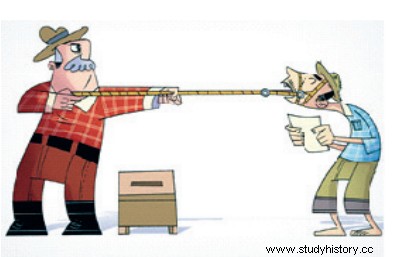 (STORNI, 1927. In:LEMOS, Renato. A history of Brazil through caricature. Rio de Janeiro:Bom Texto, Letras e Expressões, 2001.) The domination of large landowners during the Old Republic gave rise to the popular expression “halter vote”, an electoral mechanism that results from:(A) political influence of regional oligarchies b> (B) adaptation of the peasantry to the reality of the urban world (C) voter nonconformity in small towns in the interior (D) submission of rural workers to the sovereign values of cities
(STORNI, 1927. In:LEMOS, Renato. A history of Brazil through caricature. Rio de Janeiro:Bom Texto, Letras e Expressões, 2001.) The domination of large landowners during the Old Republic gave rise to the popular expression “halter vote”, an electoral mechanism that results from:(A) political influence of regional oligarchies b> (B) adaptation of the peasantry to the reality of the urban world (C) voter nonconformity in small towns in the interior (D) submission of rural workers to the sovereign values of citiesQuestion 02 - (Adapted) - Instituto Machado de Assis - 2018 - Luís Correia City Hall - PI - History Teacher -"A form of political control over the voter through coercion and abuse of authority, so that they vote for a certain candidate." In the context of History, the above fragment conceptualizes:(A) Halter vow. (B) Secret vote.(C) Mandatory vote.(D) Party vote.
Question 03 - UERJ 1997 - 1st Phase - History - Election costs:birth registration, which the kids are born and only register when it's time to vote, half a dozen portraits, lunch, ticket. Apart from the distribution of sewing machines, cow and calf loans for those who are in need of milk, free house to live in, mules for those who need to ride. And after all that, on election day, there are still a bunch of people wanting to see the candidates' names right. You can't, damn it! (...) (RIBEIRO, Marcus Venício et alii. Brasil Vivo. Petrópolis, Ed. Vozes, 1992.) The existing political mechanism in the "Oligarchic Republic" in Brazil and caricatured in the above passage is:(A) Land Law( B) halter vote (C) governors' policy(D) Commission for Verification of Powers
Question 04 - UNESP - 2006 - 1st day - Watch the charge.
 |
| UPCOMING ELECTIONS... “HALT”. |
Question 05 -
 The cartoon is an allusion to the secret a) vote, an achievement of workers' unions during the Vargas Era. b) census, in which there was a requirement of an annual income to vote and to run for public office. c) women, the result of the women's struggle in the 1930s. d) manioc, in which voting was allowed only for free men with an income equal to or greater than the value of 1.5 tons of manioc. e) halter, a characteristic of coronelismo.
The cartoon is an allusion to the secret a) vote, an achievement of workers' unions during the Vargas Era. b) census, in which there was a requirement of an annual income to vote and to run for public office. c) women, the result of the women's struggle in the 1930s. d) manioc, in which voting was allowed only for free men with an income equal to or greater than the value of 1.5 tons of manioc. e) halter, a characteristic of coronelismo.Question 06 - 2009 OBJECTIVE - “Coronelismo represented a variant of a more general socio-political relationship — clientelism —, existing both in the countryside and in the cities. This relationship resulted from social inequality, the impossibility of citizens realizing their rights, the precariousness or lack of State assistance services, the inexistence of a career in the public service. From an electoral point of view, the 'colonel' controlled the voters in his area of influence. He exchanged votes for candidates nominated by him for favors as varied as a pair of shoes, a place at the hospital or a teaching job.”
(FAUSTO, Boris. História do Brasil. São Paulo:Edusp, 1998. p. 263.) Based on the text, it is possible to state that the “halter vote”
a) did not interfere with the outcome of the elections, as voters were free to choose their candidates.
b) was the way found by the “colonels” to help the poorest voters, which strengthened the democratic process.
c) it was a practice that contributed to reducing social inequalities and strengthening the citizenship census of Brazilians.
d) it was linked to a social context of inequalities and led voters to exchange votes for short-term benefits.
e) evidenced state control over the electoral system, thanks to the use of the military to prevent electoral fraud.
Question 07 - CECIERJ 2017-1 - The following cartoon symbolizes the “halter vote”, recurrently used in the First Republic and analyzed from the political rearrangements that gave it power.
 In this electoral context, voting, according to the 1891 Constitution, was (A) reserved for voters. (B) restricted to colonels. (C) private to the richest voters. (D) exclusive to literate people.
In this electoral context, voting, according to the 1891 Constitution, was (A) reserved for voters. (B) restricted to colonels. (C) private to the richest voters. (D) exclusive to literate people.Question 08 - ESPCEx 2013 -“The period of Brazilian political history that goes from 1889 to 1930 is usually designated by historians in different ways:Oligarchic Republic, Republic of ‘Café-com-Leite’, Old Republic or First Republic. In this period, in exchange for 'favors', the colonels demanded that voters vote for the candidates they nominated. This practice became known as 'halter vow'. (COTRIM, 2009, modified) The two underlined expressions (“coronels” and “halter vote”) refer, respectively, to [A] large landowners and the secret vote. [B] career officers who held political positions and census voting. [C] the influence of Army officers in political decision-making and census voting. [D] the large landowners and the open vote given under pressure. [And] to the large landowners and the census vote.
INTRODUCTION 01 - A02 - A03 - B04 - B05 - E
06 - D07 - D08 - D
